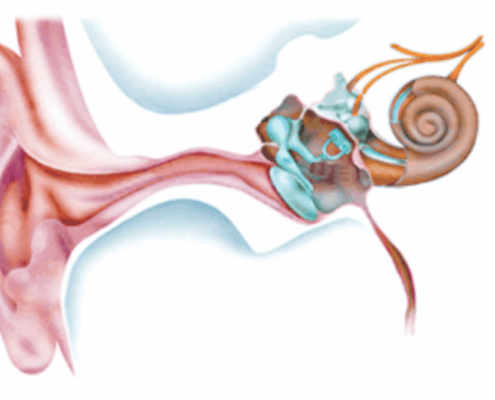
Outer Ear
Middle Ear
Inner Ear
Auditory Nerve
Ear Drum
Stapes
Hearing Bones
Cochlea
Ear Canal
Pinna
ABOUT HEARING LOSS
To gain a comprehensive understanding of hearing loss, it is crucial to grasp the fundamental workings of the ear. The ear can be anatomically divided into three distinctive sections: the outer ear, the middle ear, and the inner ear.
Beginning with the outer ear, it functions as a collector and transmitter of sound, efficiently channeling the captured auditory stimuli through the ear canal towards the eardrum. Once the sound waves reach the eardrum, they prompt vibrations in accordance with their characteristics.
Moving on to the middle ear, it encompasses the eardrum, also known as the tympanic membrane, and three diminutive bones: the hammer, anvil, and stirrup. These intricate ossicles work in harmony with the eardrum, synergistically amplifying the sound vibrations and effectively transmitting them to the inner ear.
Lastly, the inner ear, scientifically referred to as the cochlea, contains a fluid medium that receives the vibrations relayed from the ossicles. As the fluid senses the vibratory signals, it stimulates the hair cells within the cochlea. These remarkable hair cells, in turn, generate electrical impulses, which are subsequently transmitted to the auditory nerve. The auditory nerve serves as the conduit, transmitting these impulses to the brain, enabling the brain to decipher and interpret them as distinct sounds.
In summary, comprehending the intricacies of hearing loss necessitates a foundational understanding of the ear’s functional divisions: the outer, middle, and inner ear. By recognizing the role each part plays in the auditory process, one can begin to appreciate the complexity and significance of addressing hearing impairments.
CONDUCTIVE HEARING LOSS
Hearing loss attributed to issues with the ear canal, eardrum, or middle ear, including the malleus, incus, and stapes bones, can arise from various causes. These causes encompass the following factors:
- Structural abnormalities in the outer ear, ear canal, or middle ear.
- Accumulation of fluid in the middle ear resulting from colds.
- Middle ear infection, known as otitis media, characterised by the build-up of fluid that may impede the movement of the eardrum and ossicles.
- Impaired functionality of the Eustachian tube.
- Perforation of the eardrum.
- Obstruction caused by impacted earwax.
- Infection in the ear canal.
- Otosclerosis, a condition characterised by abnormal bone growth within the middle ear.
When hearing loss arises from these factors, it is essential to seek appropriate evaluation and treatment in order to address the specific underlying cause and optimise auditory function.
SENSORINEURAL HEARING LOSS (SNHL)
Hearing loss that stems from issues within the inner ear, commonly referred to as nerve-related hearing loss, can be attributed to various causes. These causes encompass:
- Prolonged exposure to loud noise, which can result in damage to the delicate structures within the inner ear.
- Head trauma or injury that affects the inner ear.
- Viral and bacterial infections, such as Meningitis, that can lead to inner ear damage and subsequent hearing loss.
- Autoimmune inner ear disease, wherein the immune system mistakenly attacks the inner ear structures.
- Hereditary factors, with hearing loss being passed down through family genetics.
- Age-related hearing loss, also known as presbycusis, which occurs gradually as a result of natural ag-ing processes.
- Malformation of the inner ear, which may be present from birth and impact hearing function.
- Meniere’s Disease, a disorder characterizsd by recurrent episodes of vertigo, hearing loss, and tinnitus, often attributed to fluid imbalances within the inner ear.
When hearing loss arises from inner ear problems, it is crucial to consult with a healthcare professional for accurate diagnosis and appropriate management strategies tailored to the specific underlying cause.
MIXED HEARING LOSS
Mixed hearing loss refers to a condition characterised by the presence of both conductive and sensorineural hearing impairments. This implies that damage may be present in the outer or middle ear, as well as in the inner ear (cochlea) or auditory nerve. In cases of mixed hearing loss, it is advisable to address the conductive component as a priority. In certain instances, the inclusion of the conductive component can potentially improve the candidacy for hearing aid usage, for instance, by creating a more balanced audiogram in the presence of an underlying high-frequency sensorineural loss. Nevertheless, the primary focus remains on medically treating any treatable aspects of the condition.
SOCIALLY
- Frequently request repetition from others during conversations.
- Experience difficulty in comprehending conversations involving more than two
individuals. - Perceive others’ speech as mumbling or unclear.
- Encounter challenges in hearing effectively in noisy environments, such as conferences, restaurants, malls, or crowded meeting rooms.
- Struggle to hear children’s and women’s voices.
- Receive complaints from family members regarding excessively high volume levels of the TV or radio.
- Engage in inappropriate responses or answers during conversations.
- Experience a persistent ringing or buzzing sensation in the ears.
- Rely on lip-reading or closely observe individuals’ facial expressions when they communicate with you.
EMOTIONALLY
- You experience increased stress as a result of exerting effort to comprehend others’ speech.
- You feel frustrated with others due to difficulties in hearing or understanding their communication.
- You feel embarrassed in social encounters and face the potential for misunderstandings.
- You experience nervousness or apprehension when attempting to hear and comprehend conversations.
- You find yourself avoiding social gatherings or activities that you previously enjoyed due to hearing challenges.


